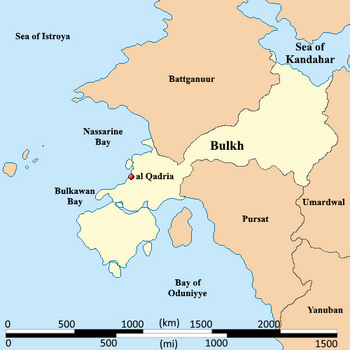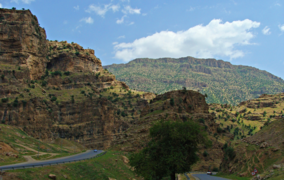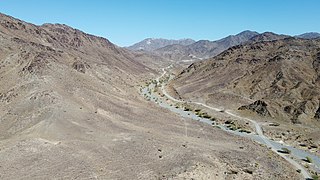Bulkh
Bulkh | |
|---|---|
|
Flag | |
Motto: Unity of purpose, unity of strength | |
 Political Map of Bulkh | |
| Capital | al Qadria |
| Government | constitutional republic |
• The Most Elected Minister | Rahani Bintuta |
| Area | |
• | 796,939.342 km2 (307,700.000 sq mi) |
| Population | |
• Estimate | 1,500,540 |
• Density | 1.88/km2 (4.9/sq mi) |
| GDP (nominal) | estimate |
• Total | $3.66 billion |
• Per capita | $2,436.46 |
| Date format | dd-mm-yy |
| Driving side | right side |
Bulkh, officially the Representative Republic of Bulkh, is a minor power sovereign country on the northwestern Puhktun Sea coast of Daria, the south eastern island of Audonia. It is neighbored by Umardwal to the west, XXX to the north, and XXX to the south. It came to its modern iteration after the Emirati War, in 1897 both geographically and politically. It is a constitutional republic with consociational representation, shared between the Arab Muslim population, Bedouin nomads, and the polity of Christians. While suffrage is universal and by secret ballot, it is still common for voters to generally follow their tribal leaders lead on issues. Bulkh is a member of the League of Nations, the International Red Cross and Red Crescent Movement,
Its primary exports are crude oil, Construction aggregate, fish, and cork. It maintains a capitalist economy but with certain controls and subsidies around critical industries like food, water, energy, healthcare, and transportation, which are typically managed as a public-private ventures.
Many scholars have criticized its governance and politics, arguing that it is merely a client of Burgundie.
History
Prehistoric era
Stone Age
Bronze Age
Iron Age
Classical Antiquity
Golden Age
Main article: Oduniyyad Caliphate
The Bedouin peoples of the Bulkawan Peninsula were resistant to the spread of Islam and conquest by the Oduniyyad Caliphate. While the Caliphs claimed the land as their own, they were never able to formalize the government and taxation system to bring the Bedouin peoples to heel. During the 900s the Caliphate attempted to migrate some Umardis to the area to remove them from southern Audonia and also to make the recalcitrant Bedouins someone else’s problem. The Umardi princes brought their culture to the area, but following the Shia schism they remained Sunni, one of the few ethnically Umardi ruled areas to do so. The Bulkawan Peninsula remained segregated between a Umardi ruling class and a Bedouin population until the fall of the Caliphate. At this point the Umardi princes were expelled back to Umalia and the various Bedouin tribes retired back into their nomadic lifestyles.
Early modern era
Following the collapse of the Caliphate the various Bedouin tribes retired back into their nomadic lifestyles. The area remained untouched until the arrival of the Kiravian and NATION colonial efforts in the 15somethings.
Colonization
The area being arid was of little use to colonists. They moved on and found other more temperate sites for settlements in the late 1570s. From 1578-1614 there was no recorded colonial activity in the area. However in 1615 a Marialanii Ularien Trading Company surveyor mapped the salt flats of the Chott al-Rezid and the company made a mad dash to secure the area.
Company rule
Main article: Marialanii Ularien Trading Company
Due to their nomadic lifestyle and their disinterest in engaging the occidentals, the Marialanii Ularien Trading Company largely left the Bedouins of the Bulkawan Peninsula alone and built their colonies around them. By the 1630s timber from Majanub was being brought to build a sprawling complex of fortified towns and salt mining operations. Businesses to support the efforts became very lucrative and wainwrights, shipwrights, and engineers flocked to the area. Beyond the Chott al-Rezid the Company build operations at the Chott al-Mouza and the Ben Ghilli Salt Flats. These operations brought millions into the Company’s coffers and is one of the primary financial activities that allowed for unfettered expansion in Audonia and Alshar. The salt mines brought tens of thousands of colonists from Burgundie, the Levantine Protestant communities on Torlen and Medimeria, as well as from other parts of Audonia. The port cities of Avelie and Sant Marten both surpassed 20,000 residents in the 1690s making them bigger than Vilauristre and NordHalle. The back-breaking work and the blistering heat made for a seedy type coming to seek work in the colony of Bulkawa. This led to rapid development of the vice sectors like prostitution and drinking halls. It also required the establishment of a vast drinking liquid network. This drove the development of the tea plantations in Vitale, Pukhgundi, and other parts of Alshar. Becoming the most profitable colony of the Company also made it the most important and the center for the formation of the Marialanii Ularien Trading Company. Seeking to exert more control on the political environment that fed into its colonies and to which it exported, the Company formed a government in Avelie and formalized its army, navy, and diplomatic corps reorganizing itself as the Marialanii Ularien Trading Empire. This was met by outrage in many nations both in Audonia and the Occidental world, however fear of embargo brought most countries to recognize the sovereignty of the empire in 1757.
In the Presidency Act of 1771, the Presidency of Bulkhawan was announced, covering much of the colony of Bulkhawa but ceded some of the western interior to the nomads as they were pushed out and forced to renounce their nomadic traditions. This led to intense bad blood between the colonial state and the locals. Colonial Battagnuuri knights were brought into to escort the Bedouins from their villages but clashes erupted in a number of areas leading to the massacre of the tribal peoples. In the 840 recorded Bedouin encampments in the area with an estimated population of 969,000 people, only 694 encampments and 539,000 people were successfully relocated. The remainder were assumed killed or dispersed into the vast desert waste. The brutal effectiveness of this dispossession of tribal homelands become a model for colonial powers post-independence powers for centuries afterwards. These “Trails of Trauma” paved the way for a huge boom in colonial growth and land redistribution. Vast areas formally reserved for the Bedouin were settled and huge irrigation projects were started to reclaim parts of the desert that were adjacent to littoral areas. There was even an ambitious plan to dredge a channel to the salt-stripped Chott al-Mouza in 1793 that was never realized.
Following the start of the Great Slavers Bay Rebellion a similar call to arms led the Bedouins to unite under Ali Malik, becoming known as Malikites, a proto-communist who wanted to rid the Bulkawan Peninsula of colonial influence and establish a collective paradise. Malik gathered a force of 20,000 Bedouin cavalry and rode west to forcibly gather support for his attempts. The following year, 1824, he returned with an army of 250,000. It is unclear if these reports are just of combat troops or included his train but regardless it was a sight to behold. The colonial troops balked and retreated with each engagement and the few occidental soldiers and officers did their best to forestall the inevitable. Fearing the loss of their imperial capital and the salt mines, the Marialanii Ularien Trading Empire hastily made treaties across Audonia and Alshar and redirected its troops to Presidency of Bulkhawan. A force of 45,000 colonial and imperial troops was formed and force-marched through the desert to meet the Malikites head-on. Arriving at the western edge of the desert in March of 1825, the Imperial army set about building a camp and reinforcing its supply lines. The massive, cumbersome western-styled army immediately fell prey to the sprightly and spirited, lightning-fast raids of the Malikite army. Their supply lines disrupted and their supply of food and water dwindling, they made a forced march to the northern coast. 540 men died of starvation and thirst along the way, but the remainder were met by the navy and brought back to Sant Marten. As equatorial winter set in all they decided to wait. Garrisons were established at the salt mines and some recently created farming communities were forcibly abandoned and the men impressed into a militia. January of 1826 saw the first attempts by the Malikites to probe the defenses of the colonial forces. The Ben Ghilli Salt Flats came under attack January 12th. A small detachment of Malikite cavalry attacked the forward watch posts and were met with cannon fire from the fortified town. A squadron of Battganuuri knights and Umardi Sipahis were dispatched to try to find the main Malitike force.
Emirate of Kagazi
After the Occidentals left the country was divided between the Malikite isocracy and the Kagazi Emirate. It wasn't long before the Malikites collapsed in the absense of a common enemy and the Emirate of Kagazi took over the majority of the lands that constituted the Audonian portions of the Presidency of Bulkhawan.
The Emirate existed until it was disestablished in 1897 at the conclusion of the Emirati War
Late modern era
Contemporary era
Operation Kipling
Main article: Operation Kipling
Globalization
Geography
-
Farming in Bulkhan interior
-
Southern mountians
-
Wadi in the a'Sa'hra Sharki (The Western Desert)
-
Coastal community
Bulkh forms the eastern most expanse of a'Sa'hra Sharki (The Western Desert) and the northwestern Puhktun Sea coast of Daria, the south eastern island of Audonia.
Climate and environment
Is your country hot or cold?
Government and Politics
Bulkh is a secular Consociational democratically elected oligarchic state with power being shared by the elites of the majority Muslim Arab community (68% of the population) and the minority Christian (20% of the population) and Bedouin (12% of the population) communities. Representatives to the Constituent Council are directly elected by their constituency and serve for a term of 3 years. There is a 4 term limit to service on the Constituent Council.
From within the elected members of the legislative body a Most Elected Minister is elected for a 6 year period to serve as the head of the executive branch. There are no term limits to the Executive branch.
Federal subdivisions
Buhlk is divided into 5 provinces and a Federal District.
- The Federal District
- Southern coastal region to be named
- Central coastal region to be named
- Northern coastal region to be named
- Northern half of the interior
- Southern half of the interior
Politics
What political factions exist? Who has ruled predominantly?
Law
What kind of laws and legal system does your country employ?
Demographics
What kind of people live in your country?
Ethnicity
What ethnic groups make up your country?
Language
What language or languages do your country's people use? Are there any previously used languages no longer common? Are these languages native to your country or shared with another?
Religion
Religious affiliations in the XXX (20XX)
What do your country's people believe in religiously, if anything? How many groups are there?
Education
How many people in your country are educated?
Culture and Society
What do your people do, and what are they like?
Education
What is your country's education system like? How do the schools work? What do people think about education?
Attitudes and worldview
How do your country's people view life?
Kinship and family
How are families or kinship groups structured in your country?
Cuisine
What do your people eat?
Religion
What do your people believe? Rather than demographics, as above, think about how important religion is to your people and their view about their own and other religions. What is the relationship between the prevailing view and minority religious groups? Is it an official religion, and do any laws exist about free worship?
Arts and Literature
What type of art do your people make? Do they have a tradition of painted art, well-crafted television shows, or great music?
Sports
Does your country have any major sports leagues? What types of sports are played, both professionally and for fun by your country's people?"
Symbols
Are there any prominent symbols which are well known to represent your country?
Economy and Infrastructure
How does your country's economy work?
Industries and Sectors
What are the largest parts of your economy in terms of what they do?
Currency
What exchange systems are used within your country's economy?
Healthcare
How do people in your country procure medical care? How is it paid for?
Labor
How is labor organized within your country? Are there any social institutions or unions which deal with labor concerns?
Transportation
How do people in your country get around? Is there a major highway system as well as sea- and airports?
Energy
What type of energy keeps your nation going? Are you renewable or use fossil fuels, and if you are renewable, how recently did your country transition?
Technology
How advanced is your country? Is it an innovator, or does it largely import new developments?
Military
How large is your country's military? Is it large but poorly equipped or small and elite? Does your country have a martial tradition?
See Also
Ba'athist Ixraq



